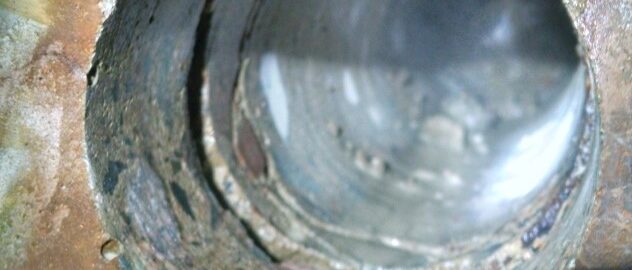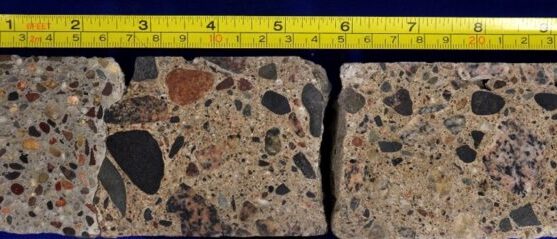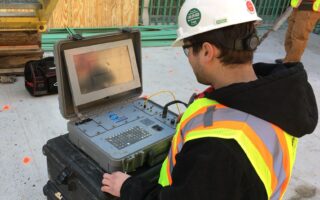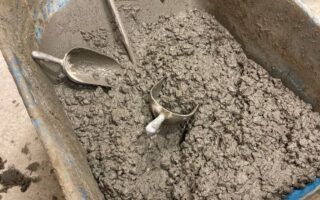Keeping the end in mind is a critical step in any nondestructive evaluation. Nondestructive testing (NDT) techniques are used in damage analysis and repair design of structures without further damage or alteration. These techniques can also help avoid downtime, disruption to nearby workers and structures, and save on material costs. To promote the best outcome, potential costs, timeline, and repair options should all be considered before the evaluation begins.
In this article, we will discuss a project involving a 60-year-old crusher foundation in a mining operation. The crusher was scheduled for replacement and an in-depth review of the foundation was needed. Repairs had already occurred on the columns and additional repairs, or a complete replacement, could be accomplished during the installation of the new crusher. The team strategized how best to evaluate the structure due to fatigue damage from over 60 years of vibration.
Mapping Cracks and Defects with Ultrasonic Waves
The project team chose a nondestructive testing method known as ultrasonic pulse velocity (UPV) to assess possible fatigue issues in the concrete. UPV uses sound waves transmitted through concrete to measure the speed of sound. When evaluating fatigue issues in concrete, this catch and pitch method is ideal. Fatigue after 60 years of vibration would cause cracking, especially around the aggregates, which would slow the sound wave as it passes through the concrete. Most published research recognizes 3000 to 3500 meters per second (m/s) as an acceptable threshold for velocity of sound concrete. Below those velocities, the concrete is of questionable quality. Keep in mind the UPV technique measures soundwaves through concrete and anomalies in the velocity are due to unknown causes. Without Superman’s x-ray vision, alternative ways for determining the causes are required. On this project, strategic cores and petrographic analysis were conducted to determine root cause of reduced velocities.
The project team faced unique challenges in this evaluation due to the conformation of the structure, consisting of a rectangular foundation and four columns, as seen in Figure 1. The team was able to conduct pulse velocity (with careful calibration) through the width of the columns (Fig. 2) and on angles for the rectangular foundation. Some test locations in column areas provided no signal transmission and other column locations provided variable velocities. The foundation yielded similar results with variable velocities. A sample of the velocities measured are provided in Table 1. The table is color formatted to provide easy observation of areas of concern.

Table 1: Pulse Velocity Results in Foundation (m/s)

“Extracting” Further Information through Concrete Coring
As the nondestructive testing revealed several areas of concern in the columns and foundation, core extraction was chosen as the supplemental technique to provide more information about the concrete’s condition. Cores were extracted from various areas representing the different results from the NDT, in all five structural elements to correlate the NDT to the physical condition of the concrete. Observation of the cores confirmed the concrete was cracked from decades of vibration from the operating crusher above, but only on the exterior of the columns. Figures 3, 4, 5, and 6 provide examples of the coring operation, images of the core holes and the polished sections of the cores.
On this project, the NDT provided a great way to quickly test the columns and the foundation in a grid pattern covering a large area. The result of the NDT allowed for the coring locations to be selected strategically instead of randomly. Additionally, the number of cores required to evaluate the structures was dramatically reduced as only six cores were extracted and evaluated.
Petrographic analysis of the cores was able to reveal information about the concrete that the NDT alone could not — that the concrete did not contain microcracking. The macrocracking seen in the core holes and cores, were in fact, limited only to the concrete on the exterior of the reinforcing. The concrete, at a greater depth than the reinforcing steel, was in good condition and structurally sound. This allowed for repair of the column to include patching and carbon fiber wrapping of the columns saving our client time and money in the installation of the new crusher.
If you would like to learn more about nondestructive techniques used in the condition assessment of concrete structures, please join us on April 21st for a live webinar with Braun Intertec Concrete Technical Leader, Alf Gardiner, PE, LEED AP, and the Vice President for the Building and Structure Sciences (BaSS) group, Tim Tonyan, PhD.








